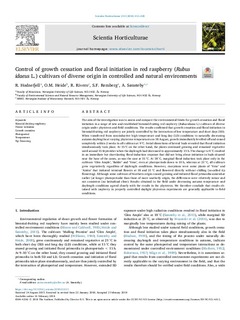Control of growth cessation and floral initiation in red raspberry (Rubus idaeus L.) cultivars of diverse origin in controlled and natural environments
Journal article, Peer reviewed
Published version
Permanent lenke
http://hdl.handle.net/11250/2498165Utgivelsesdato
2018-03-15Metadata
Vis full innførselSamlinger
- Publikasjoner fra CRIStin - NIBIO [4575]
- Vitenskapelige artikler [1416]
Sammendrag
The aim of the investigation was to assess and compare the environmental limits for growth cessation and floralinitiation in a range of new and established biennial-fruiting red raspberry (Rubus idaeus L.) cultivars of diverseorigin under phytotron and field conditions. The results confirmed that growth cessation and floral initiation inbiennial-fruiting red raspberry are jointly controlled by the interaction of low temperature and short days (SD).When transferred from non-inductive high temperature and long day (LD) conditions to naturally decreasingautumn daylengths at varying phytotron temperatures on 18 August, growth immediately levelled off and ceasedcompletely within 2 weeks in all cultivars at 9 °C. Serial dissections of lateral buds revealed that floral initiationsimultaneously took place. At 15 °C on the other hand, the plants continued growing and remained vegetativeuntil around 15 September when the daylength had decreased to approximately 13 h. The change to 9 °C resultedin an immediate but short-lasting floral induction response that did not bring about initiation in buds situatednear the base of the canes, as was the case at 15 °C. At 18 °C, marginal floral induction took place only in thecultivars ‘Glen Ample’, ‘Balder’ and ‘Vene’, even at photoperiods down to 10 h, whereas at 21 °C, all cultivarsgrew vegetatively regardless of daylength conditions. However, exceptions were some plants of ‘Vene’ and‘Anitra’ that initiated terminal flowers at 18 and 21 °C and flowered directly without chilling (so-called tipflowering). Although some cultivars of Northern origin ceased growing and initiated floral primordia somewhatearlier (at longer photoperiods) than those of more southerly origin, the differences were relatively minor andnot consistent (no latitudinal cline). Results obtained in the field under decreasing autumn temperature anddaylength conditions agreed closely with the results in the phytotron. We therefore conclude that results ob-tained with raspberry in properly controlled daylight phytotron experiments are generally applicable to fieldconditions.

